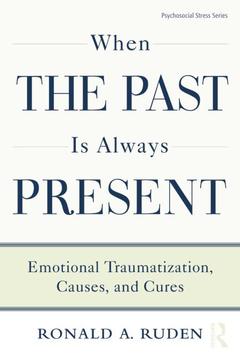When the Past Is Always Present Emotional Traumatization, Causes, and Cures Psychosocial Stress Series
Auteur : Ruden Ronald A.

When the Past Is Always Present: Emotional Traumatization, Causes, and Cures introduces several new ideas about trauma and trauma treatment. The first of these is that another way to treat disorders arising from the mind/brain may be to use the senses. This idea, which is at the core of psychosensory therapy, forms what the author considers the "third pillar" of trauma treatment (the first and second pillars being psychotherapy and psychopharmacology). Psychosensory therapy postulates that sensory input?for example, touch?creates extrasensory activity that alters brain function and the way we respond to stimuli.
The second idea presented in this book is that traumatization is encoded in the amygdala only under special circumstances. Thus, by understanding what makes an individual resistant to traumatization we can offer a way of preventing it.
The third idea is that traumatization occurs because we cannot find a haven during the event. This is the cornerstone of havening, the particular form of psychosensory therapy described in the book. Using evolutionary biological principles and recently published neuroscientific studies, this book outlines in detail how havening touch de-links the emotional experience from a trauma, essentially making it just an ordinary memory. Once done, the event no longer causes distress.
Feinstein, Foreword. A Third Pillar. The Role Emotions Play. Ancient Emotions and Survival. Memory and Emotion. Encoding a Traumatic Memory. Causes and Consequences of Traumatization. Disrupting a Traumatization. Havening. A Brief Introduction to Psychosensory Therapies. Trauma Stories and Trauma Cures. Appendices. Appendix A: Non-touch Havening. Appendix B: Cultivating Resilience. Appendix C: An Analysis of Fear of Flying. Appendix D: Nightmares, Night Terrors, Just Bad Dreams and Havening. Appendix E: Classical Fear Conditioning and Traumatization. Appendix F: Transduction, Depotentiation and the Electrochemical Brain. Appendix G: Suggestions for Treatment. Appendix H: Havening Touch: Clinical Guidelines. Appendix I: The Downside of Removing a Traumatic Memory. Notes and Additional References. Glossary.
Since 1983, Ronald A. Ruden has run an internal medicine practice in Manhattan and dedicated part of the proceeds to follow research interests. His first efforts were described in his book, The Craving Brain, a neurobiological discussion of addictive behaviors. In 2003 he began a new research project involving the understanding of traumatization that has led to three publications in Traumatology, edited by Charles Figley, and to this book. He continues his research on traumatization.
Date de parution : 07-2015
15.2x22.9 cm
Date de parution : 10-2010
15.2x22.9 cm
Thème de When the Past Is Always Present :
Mots-clés :
Defensive Rage; Chronic; defensive; Glutamate Receptors; rage; Wo; fear; Working Memory; response; Limbic System; unconditioned; UFS; stimulus; Feeds Back; sensory; EMDR; input; Eft; stimuli; Gaba; obsessive; Traumatic Memory; Panic Disorder; Traumatic Component; Fear Response; Gaba Interneuron; Gaba Neuron; BLA; Accessory Basal Nucleus; Synaptic Consolidation; Freeze Discharge; Pelvic Floor Dysfunction; Life Force Energy; Visual Spatial Sketchpad; Bran Muffins



